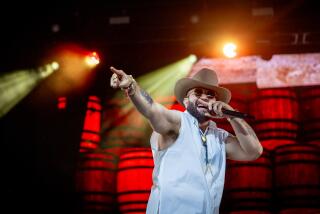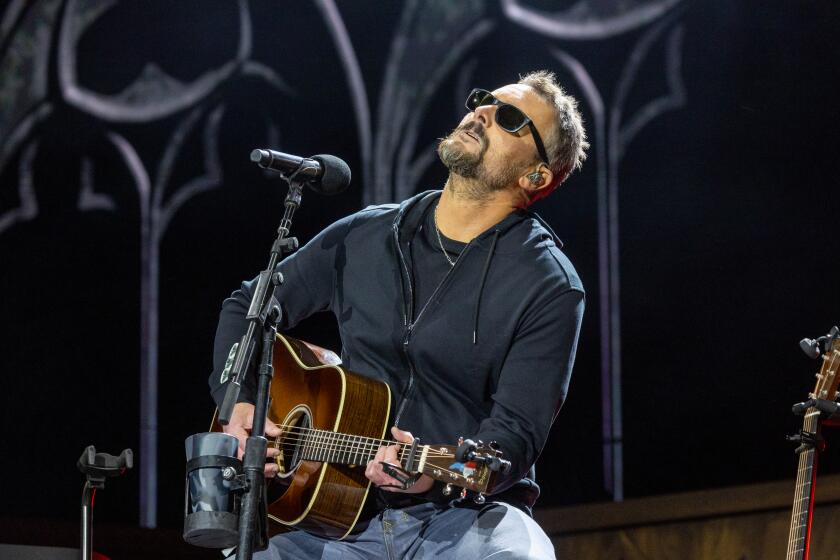The kids are all right
Music at the Playboy Jazz Festival always has been inextricably connected to the sun, the wine and the partying, and this year was no exception. But what was particularly interesting about the 30th anniversary event at the Hollywood Bowl Saturday and Sunday was the youthful energy on display -- though, unfortunately, the younger performers received less attention than they deserved.
The performance of 27-year-old pianist Robert Glasper on Saturday, for example, took place at the very beginning of the afternoon, when seats were only half-filled, and audience members were paying far more attention to getting situated for the long day ahead than they were to the music. Which was a shame, since Glasper played with fire and imagination, as adept with straight-ahead mainstream playing as he was with contemporary, postmodern methods of improvisation.
Singer Ryan Shaw, 26, placed in a similarly early slot Sunday, also sang to a sparse crowd. But his set was fascinating nonetheless for its revival of a time when jazz, rock music and the blues had a much more intimate relationship than they do today.
Japanese keyboardist Hiromi, 29, appeared later in the afternoon Saturday but had the questionable luck of being positioned between Bill Cosby’s “Cos of Good Music” all-stars and the inimitable veteran saxophonist James Moody.
Her performance, however, was a marvel -- an impressive display of creative development well beyond what she presented a year or so ago in a local club date.
The youngest new talent on the program, singer Sonya Kitchell, 19, had the best spot of all -- performing with the festival’s headliner, Herbie Hancock. Singing selections from Hancock’s Grammy Award-winning album “River: The Joni Letters,” she revealed a talent for the phrasing and rhythmic qualities of jazz, enhanced by a golden sound. Hancock and his all-stars -- including unexpected guest Wayne Shorter -- also explored other pieces from his expansive catalog, affirming his position as the current leader of the jazz wave.
--
Happy hour slot
Brazilian artist Ivan Lins too suffered from a programming position that placed him in the middle of 4 p.m. cocktail and socializing time. In the process, his lovely versions of “Velas” and “Dindi” -- as well as a pairing on a few tunes with veteran guitarist-singer Oscar Castro-Neves -- were obliged to fight their way through audience socializing. To Lins’ credit, he managed to do so, leading an ensemble of Brazilian players whose work powerfully attested to the global reach of jazz.
Dee Dee Bridgewater’s offering of music from her “Red Earth: A Malian Journey,” in the company of a colorful collection of African musicians and singers, added another touch of diversity to the bill. Bridgewater always has been a versatile performer but never so much as she was with this ensemble, blending jazz with traditional African rhythms and melodies.
--
Jarreau takes over
But it was Al Jarreau who stole that the show on Saturday. He was brilliant, romping through tunes such as “Take Five” with swing, imagination and charisma.
And the diversity reached into other body-moving areas as well: the gumbo rhythms of Dr. John; the blues of Keb’ Mo’, sizzling Latin jazz and salsa grooves from Poncho Sanchez and Plena Libre; the funk of Tower of Power and the grooves of Guitars and Saxes. Less appealing were trumpeter Rick Braun and saxophonist Richard Elliot’s over-the-top, showoff antics.
Big band fans were rewarded with a fiery set from New York-based, all-female Diva Jazz Orchestra, led by drummer Sherrie Maricle, and trumpeter Roy Hargrove’s large ensemble, featuring the stunning vocals of Robert Gambarini.
And then there was saxophonist James Moody. At 83, he was at the far end of the generation spectrum from Kitchell. But a youthful spirit was present in his playing, his singing and his joyous sense of humor.
Singing Eddie Jefferson’s words to his own “Moody’s Mood for Love,” he reminded his enthusiastic listeners of the timelessness that jazz, at its best, can display.
More to Read
The biggest entertainment stories
Get our big stories about Hollywood, film, television, music, arts, culture and more right in your inbox as soon as they publish.
You may occasionally receive promotional content from the Los Angeles Times.






